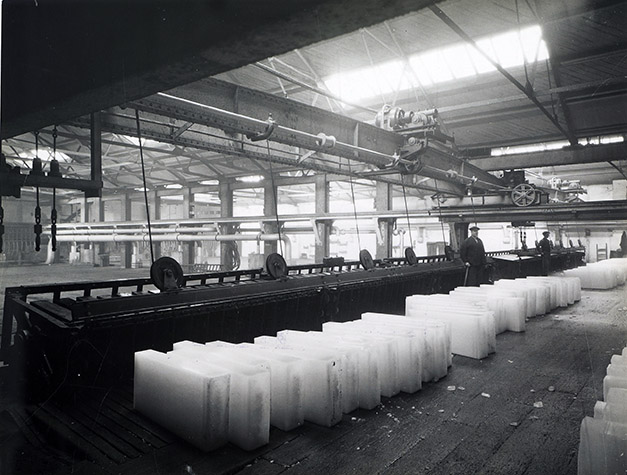Ice Factory preservation plans approved
31st December 2021
UK: Some of the historic ice-making equipment in the derelict Grimsby Ice Factory is to be removed in planned remedial work to prevent further damage to the crumbling building.
An application for listed building consent submitted by developer Tom Shutes was granted by North East Lincolnshire Council at the end of November subject to a number of conditions.
The plans to make the 120-year-old building wind and watertight include the insertion of metal security doors and timber boards to the ground floor level and upper openings, the replacement of existing glass from windows with translucent Perspex, the repair/replacement of parts of the roof and roof structure and the replacement of existing rainwater gutters and downpipes.
According to the developers, the roof repairs will require the removal of some internal machinery to gain access. This includes the removal of three ice tanks and part of a further ice tank.
The plans revealed by businessman Tom Shutes would retain the surviving antique refrigeration equipment, including four 90-year-old J&E Hall ammonia compressors, and make them a feature of the new building.
Heritage
The Grimsby Ice Factory was opened in 1901 as a joint initiative between the Grimsby Ice Company and the Grimsby Co-operative Ice Company. It was the largest factory of its kind in the world, supplying ice to one of the busiest fishing fleets in the world’s largest fishing port.
Since closing in 1990, the Ice Factory has stood mothballed on the Grimsby dockside, it’s historic refrigeration machinery left undisturbed but rusting as the building around it gradually succumbs to the elements.
As the North East Lincolnshire Council recognises: “The Ice Factory is a Grade 2* listed building. It is internationally significant as a remnant of the former fishing industry in Grimsby and more specifically the ice making process.
“The equipment within forms a rare surviving example of the ice making process used to support the fishing activities on the dock.”
Wide support
The proposals received wide support from interested parties including the Victorian Society, Historic England, Twentieth Century Society, the Great Grimsby Heritage Action Zone and the Great Grimsby Ice Factory Trust. All recognised the need to arrest the decline of the building but voiced concerns over the removal of the ice making equipment.
The Victorian Society, a UK charity dedicated to protecting Victorian and Edwardian heritage, said it supported the proposals “in principle” but expressed concerns over the extent of the removal of equipment.

Architectural heritage charity, the Twentieth Century Society, sees the loss of the ice tanks being justified by the need to re-roof the building and prevent further deterioration but joined with the local authority’s conservation team and by Historic England that good examples of equipment in the tank rooms should be retained.
In its appraisal, North East Lincolnshire Council recognised that removal of historic machinery from the ice tank room was he only viable option in order to be able to inspect and secure the roof.
“It is acknowledged that the machinery which demonstrates the former process of the building is a fundamental part of the buildings significance and indeed, its removal is harmful. That being said, without this intervention to inspect and secure the roof, the building is at significant risk of the roof fully collapsing in,” it said.
“Whilst allowing the removal of the machinery, it is necessary to ensure that what machinery is salvageable is kept and safety stored as to ensure it can be reinstated at such a time a proposal comes forward for the site and to this end, strict conditions have been agreed with regard to the methodology for retention, removal and safe storage.”
The conditions of the listed building consent names specific pieces of historic machinery within the southern and eastern ice tank rooms to be retained as a representative example of former process. This includes can filling equipment, ice tank channel, thawing tank and tipping basket, ice cans, ice can motor, slatted tipping floor panels a minimum 5m section of conveyor, ice crushers and elevators.
The 1930s J&E Hall ammonia compressors on the ground floor are unaffected by this work.
An in-depth history of the Grimsby Ice Factory was previously the subject of a three-part Cooling Post series:







